The purpose of the drive shaft and universal joints is to transmit the drive from the gearbox to the back axle with a smooth transmission of torque even though the gearbox and pinion shaft are never in exact alignment.
The shaft is a hollow tubular steel unit with a hook joint at each end. The joint consists of two u shaped ‘yokes’ which are connected at 90° to each other by a four-legged cross or ‘spider’. Needle roller bearing may be used to support the spider legs in the yokes.
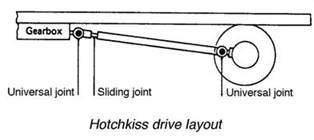



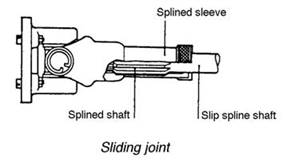

When universal joints are used to connect two units (e.g. gearbox and back axle) the driven shaft does not rotate with uniform velocity i.e. it does not turn at the same speed during each part of a revolution. In one revolution the driven shaft is accelerated twice and decelerated twice. This effect being increases as the angularity is increased. These velocity differences can be cancelled in the propeller shaft by the use of two correctly aligned joints, the acceleration of one being neutralised by the deceleration of the second. A sliding joint is used to allow the drive shaft to change its length as it rotates, to compensate for the small backward and forward movement of the rear axle caused by the action of the suspension system. It is simply a splined tubular portion built onto the forward universal joint and it slides in splines on the gearbox mainshaft.
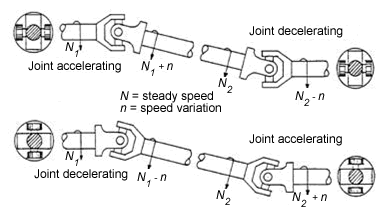
Two universal joints connected in series
Due to the high speeds the drive shaft reaches, in top gear its R.P.M. is the same as the engine, the shaft must be balanced to avoid vibration. If vibrations occur in the drive shaft it may be due to worn or broken needle rollers in the universal joint. This may be checked by turning the drive shaft by hand to check for free play, a seized joint may not be detected this way so removal of the shaft may be necessary for further checks.
Small cars and short vans and trucks are able to use a single propeller shaft with a slip-joint at the front end without experiencing any undue vibration. However, with vehicles of longer wheelbase, the longer propeller shaft required would tend to sag and under certain operating conditions would tend to whirl and then set up sympathetic resonant vibrations in the body of the vehicle - that is, cause the body to ‘drum’ or vibrate as the shaft whirls.


Simple one-piece propeller shaft with one slip-joint and two universal joints
Two-piece drive-lines, with two shafts and an intermediate support bearing are generally used on trucks with wheel bases from 3.4 to 4.8 m, but there is some overlap depending on the vehicle’s work role.


Two-piece drive-line with single intermediate support bearing
The two-piece propeller shaft has three universal joints, and the primary propeller shaft is of the fixed-joints-and-tube-assembly type, but the secondary propeller shaft has a slip-joint at the support-bearing end to accommodate any elongation due to suspension movement. Usually the primary shaft is in line with the gearbox mainshaft axis, but the secondary propeller shaft is inclined slightly so that it intersects the rear-axle final-drive pinion shaft.


Three-piece drive-line with two intermediate support bearings
For vehicles with wheelbases over 4.8 m, a three-piece drive-line with two intermediate support bearings may be necessary. There are four universal-joints, and it can be seen that the intermediate shaft lies parallel to the output shaft of the gearbox. Again only the rear propeller shaft incorporates a slip-joint to compensate for shaft length change.
Intermediate propeller-shaft bearing-and-mount assemblies are provided to position and support the divided or split propeller shafts. The support-bearing assemblies are of two basic types:
Self-aligning intermediate-bearing supports have mostly been used on heavy-duty trucks. One type of self-aligning bearing support is a double-row ball-bearing with a deep-grooved inner race and an internally semicircular outer race—Fig (a). With this arrangement, any shaft deflection is accommodated by the inner race and balls tilting about the fixed outer-race spherical seat.
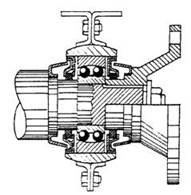

Commercial vehicle double-row self-alignment bearing support
A second method of providing self-alignment for the split shafts is achieved by a single-row deep-grooved ball-bearing with a spherical profile on the periphery of the outer races. The ball race is then received in a steel support ring which has an internal profile to match the outside of the bearing—Fig. (b). If there is any misalignment in service, relative movement of the bearing and the ring can take place without imposing strains on the bearing assembly. Both arrangements discussed need to be lubricated periodically and oil-seals are provided to retain the grease and keep dirt out of the bearing tracks.
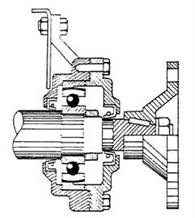

Commercial vehicle single-row self-alignment outer bearing race
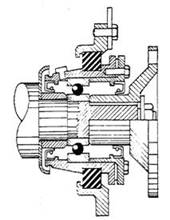 Flexible-mounted intermediate-bearing supports for divided shafts may be used for both light and heavy vehicles. All these types tend to have a single-row deep-grooved ball-bearing which fits directly over one of the divided shafts and surrounding this bearing is a rubber member which is enclosed in a steel frame. The intermediate shafts are then given support by bolting this assembly to the chassis or body shell. This rubber mounting provides a flexible support for the bearing so that a slight tilt of the shaft can be accommodated. In addition, the flexible rubber acts as a vibration damper and isolates any propeller-shaft vibrations from the body members.
Flexible-mounted intermediate-bearing supports for divided shafts may be used for both light and heavy vehicles. All these types tend to have a single-row deep-grooved ball-bearing which fits directly over one of the divided shafts and surrounding this bearing is a rubber member which is enclosed in a steel frame. The intermediate shafts are then given support by bolting this assembly to the chassis or body shell. This rubber mounting provides a flexible support for the bearing so that a slight tilt of the shaft can be accommodated. In addition, the flexible rubber acts as a vibration damper and isolates any propeller-shaft vibrations from the body members.
For extra-heavy duty, a solid rubber ring block fitting over a bearing hub, may be used—Fig. (c). It can be seen that the inner bearing race is held in position by the universal-joint flange and that the outer bearing race is located by a shimmed sleeve. Regular lubrication is necessary with this assembly. Most light-and heavy-duty intermediate-bearing assemblies now use pre-greased and sealed-for-life deep-groove bearings.
Heavy-duty rubber block bearing mount
Torque reaction—‘To every action there is an equal and opposite reaction.’ This statement means that every component that produces or changes a torque will also exert an equal and opposite torque tending to turn the casing. For example, when the engine crankshaft exerts a torque in a clockwise direction, the cylinder block will tend to rotate in an anticlockwise direction.
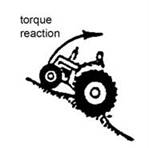

A further example of torque reaction is shown in which a tractor with its rear driving wheels locked in a ditch. In this situation the driver must be careful, because torque reaction is likely to lift the front of the tractor rather than turn the rear wheels.
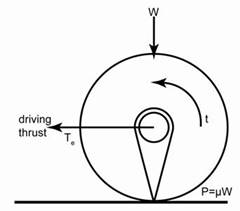

Lever action of wheel
When the law stated above is applied to rear axles, you will see that some arrangement must be provided to prevent the axle casing turning in the opposite direction to the driving wheels.
Two rear leaf springs, longitudinally mounted, are connected to the frame by a ‘fixed’ pivot at the front, and swinging shackles at the rear. At each end of the exposed or ‘open’ type propeller shaft is fitted a universal joint, with provision made for alteration in shaft length, which occurs when the springs are deflected.
Torque reaction is resisted by clamping the axle to the springs by means of ‘U’ bolts. Under heavy driving conditions the springs will deflect up at the front and down at the rear, and vice versa during braking.
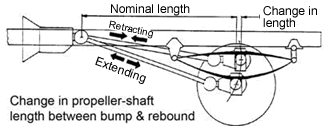
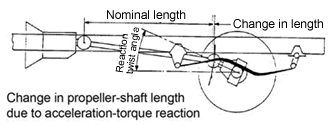
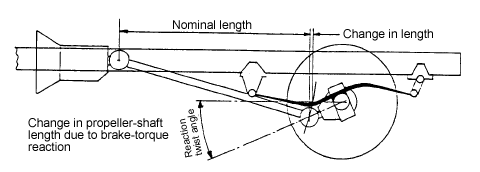
Hotshkiss drive and suspension
Vehicles with front wheel drive require a special universal joint to maintain torque at the wheel whilst turning a corner. The joint is called a constant velocity joint. This joint does not have the disadvantage of the Hookes type joint where two joints are necessary to maintain uniform velocity. In this joint a mechanism is incorporated between the “yokes” which automatically align itself when the angle is formed by the two shafts. The alignment may be obtained through the movement of steel balls in grooves or through the deflection of rubber components - these deflections neutralising the velocity variation.
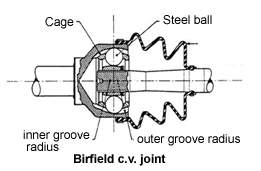
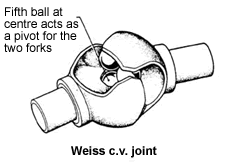
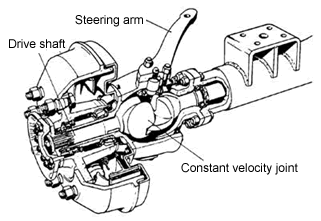
‘Tracta’ type constant-velocity universal joint fitted to a front wheel drive axle
As the vehicle turns a corner, the inner wheel moves through a smaller distance than the outer, the wheels will take the same time to turn the corner so the outer wheel must move faster to cover the greater distance. If a differential was not employed a lot of tyre scrubbing would take place and the vehicle would be hard to control.
In the differential assembly the difference in road resistance on each side of the vehicle causes the sun wheel to rotate the planet gears which increases the speed of the outer wheel, decreases the speed of the inner wheel at the same proportion, while maintaining an equal torque at both wheels.
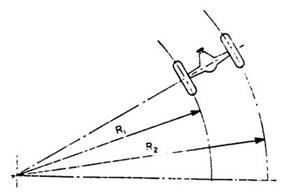

Note: Unequal rear tyre pressure, bad road conditions also brings in the differential assembly into operation.
The rear axle is where the final increase in torque and decrease in engine speed takes place. Because of the large-diameter wheels required to carry the heavy loads, a very high torque is required at the end of the half shaft to turn the wheels and propel the vehicle. The axle casing is usually a banjo-type casting with support bearings for the rear wheels at each end and a detachable casting which houses the differential gears and crown wheel assembly.


On light commercial vehicles, a conventional spiral bevel of hypoid-type rear axle construction is used. As the load-carrying capacity of the vehicle increases, the axle ratio also has to be increased to give the required torque at the rear wheels. When this ratio reaches approximately 8:1 the single bevel gear axle gives way to a worm and wheel arrangement or uses a double reduction arrangement to give the desired ratio within creased strength.
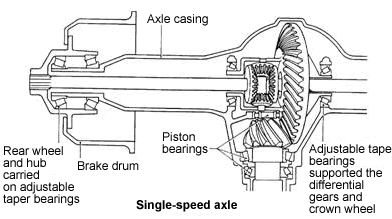
Three main methods are used to support the half shafts in the rear axle case. In all of them the inner ends of the shafts are splined into and supported by the sun wheels of the differential assembly. The differences lie in the arrangement of the hub bearing in relation to both the case and the shaft and in the forces or loads imposed upon the shaft itself.
The hub and the half shaft are, in effect, a one piece unit although they may in fact be splined or fitted together by means of a taper, key and lock nut. The bearing is carried on the shaft and is located by a nut or a sleeve. The outer track of the bearing is fitted into a recess in the axle case and is located by a retainer plate bolted to the end flange of the axle case. This bearing is usually sealed on one side to prevent excess lubricant ruining the brake lining.
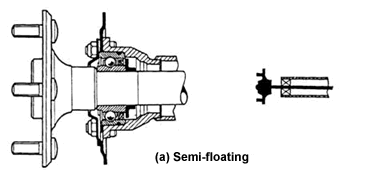
The bearing is mounted on the casing and is held against a shoulder by a locknut and tab washer. The hub is made in two parts, the inner part fitting over the bearing and also enclosing a spring loaded oil seal. The outer part may be integral with the half shaft, be splined and interference fit upon it or be secured to the shaft by a taper, key and locknut. The brake drum may be integral with the hub outer half or secured to it by counter sunkheaded screws. The back plate mounting flange is nearer to the centre of the axle than the semi-floating design. This design is mainly on light commercial vehicles.
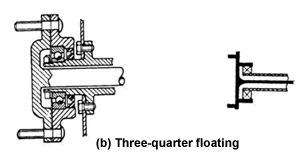
This design is mainly used on heavy commercial vehicles. The hub is a heavy forging or casting of steel and is carried on the axle case by two heavy duty opposed taper roller bearings. The tracks of these bearings are located by shoulder and a locknut and are adjustable. The hub drive plate is integral with the shaft and is secured to the hub by radially arranged set bolts, a gasket fitted between the two. A spring loaded oil seal is fitted into the inner side of the hub near the back plate flange. The half shaft may be removed without removing the wheel.

Torsional (twisting) forces due to the driving and braking thrusts.
Note: In all of the designs described the breaking of a half shaft will result in the loss of driving torque due to the action of the differential unit.
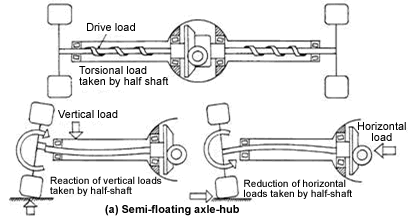
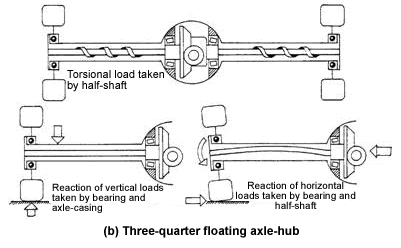
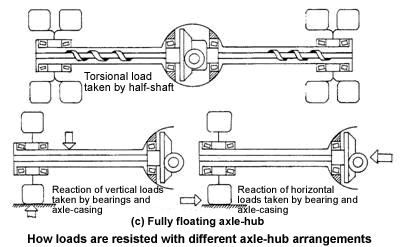
The transversely mounted engine is bolted to a unit called a transaxle. This unit gets its name from the two words transmission (a term used in America for gearbox) and axle. In the past the general term ‘rear axle’ often applied to the gearing as well as the axle casing, but nowadays the various drive arrangements make it necessary to restrict the use of the name ‘rear axle’ to the member which performs the axle duty. The two main components inside the axle of a rear-wheel drive vehicle are the final drive, e.g. crown wheel and pinion, and the differential.

The four-speed gearbox has two shafts: an input shaft splined to the clutch and a mainshaft connected to the final drive pinion. A bevel gear final drive is necessary when the engine is mounted longitudinally but in the layout shown, the engine position allows the use of normal helical gears. Drive from the final drive is transmitted through the differential to the two drive shafts. Speed variation due to drive shaft angularity is prevented by using constant velocity universal joints at each end; the inboard joint at each side being of the plunge type.
During acceleration, or at times when the engine is used as a brake, torque reaction tends to make the engine rotate about the crankshaft, so suitably spaced engine mountings are fitted to resist this movement.
Driving thrust and braking torque are taken by the suspension members, in particular the tie bar fitted from the track control arm to the body.
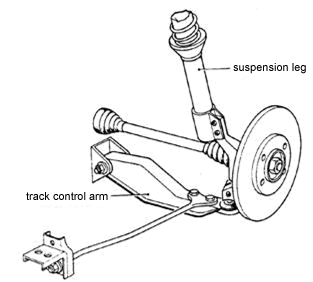
Source: http://local.ecollege.ie/Content/APPRENTICE/liu/hvm_notes/M4U3+4.doc
Web site to visit: http://local.ecollege.ie
Author of the text: indicated on the source document of the above text
If you are the author of the text above and you not agree to share your knowledge for teaching, research, scholarship (for fair use as indicated in the United States copyrigh low) please send us an e-mail and we will remove your text quickly. Fair use is a limitation and exception to the exclusive right granted by copyright law to the author of a creative work. In United States copyright law, fair use is a doctrine that permits limited use of copyrighted material without acquiring permission from the rights holders. Examples of fair use include commentary, search engines, criticism, news reporting, research, teaching, library archiving and scholarship. It provides for the legal, unlicensed citation or incorporation of copyrighted material in another author's work under a four-factor balancing test. (source: http://en.wikipedia.org/wiki/Fair_use)
The information of medicine and health contained in the site are of a general nature and purpose which is purely informative and for this reason may not replace in any case, the council of a doctor or a qualified entity legally to the profession.
The texts are the property of their respective authors and we thank them for giving us the opportunity to share for free to students, teachers and users of the Web their texts will used only for illustrative educational and scientific purposes only.
All the information in our site are given for nonprofit educational purposes